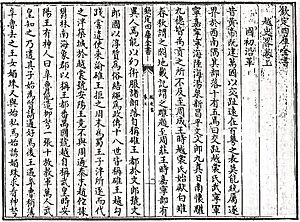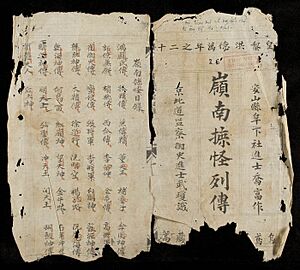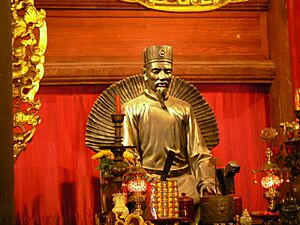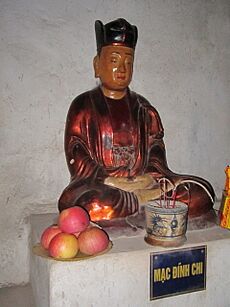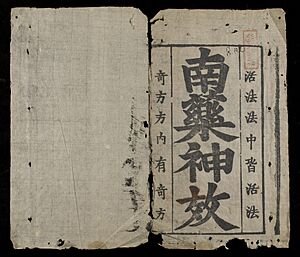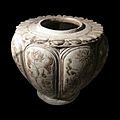Trần dynasty facts for kids
Quick facts for kids
Great Việt
大越國
Đại Việt Quốc |
|||||||||
|---|---|---|---|---|---|---|---|---|---|
| 1225–1400 | |||||||||

The expansion of Đại Việt. Trần dynasty from 1301 to 1337.
|
|||||||||
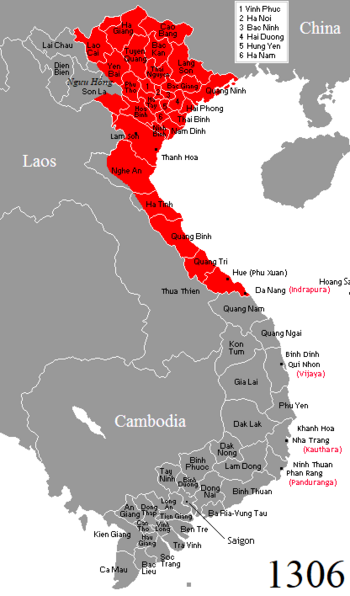
The territory of Đại Việt in 1306 after the marriage of Vietnamese princess Huyền Trân and Cham king Jaya Simhavarman III. The province of O (Cham: Vuyar) and Ly (Cham: Ulik) was ceded to Đại Việt as dowry.
|
|||||||||
| Status | Internal imperial system within Chinese tributary (Song 1225–1258) (Yuan 1258–1368) (Ming 1368–1400) |
||||||||
| Capital | Thăng Long (1225–1397) Thanh Hóa (temp) (1397–1400) |
||||||||
| Common languages | Literary Chinese Vietnamese |
||||||||
| Religion | Buddhism (official), Taoism, Confucianism, Vietnamese folk religion | ||||||||
| Government | Monarchy | ||||||||
| Emperor | |||||||||
|
• 1226–1258
|
Trần Thái Tông (first) | ||||||||
|
• 1258–1278
|
Trần Thánh Tông | ||||||||
|
• 1278–1293
|
Trần Nhân Tông | ||||||||
| Chancellor | |||||||||
|
• 1225
|
Trần Thủ Độ (first) | ||||||||
|
• ?
|
Trần Quốc Toản | ||||||||
|
• ?
|
Trần Khánh Dư | ||||||||
|
• ?
|
Trần Quang Khải | ||||||||
|
• 1387
|
Hồ Quý Ly (last) | ||||||||
| Historical era | Postclassical Era | ||||||||
|
• Coronation of Trần Cảnh
|
January 10 1225 | ||||||||
|
• Regent of Trần Thừa and Trần Thủ Độ
|
1226 | ||||||||
|
• Mongol invasions of Vietnam
|
1258, 1285 and 1287–88 | ||||||||
|
• Coup overthrown of Dương Nhật Lễ
|
1370 | ||||||||
|
• Trần Thiếu Đế ceded the throne to Hồ Quý Ly
|
March 23 1400 | ||||||||
| Currency | Copper-alloy cash coins | ||||||||
|
|||||||||
| Today part of | Vietnam China Laos |
||||||||
| Trần |
|||
|---|---|---|---|
| Country: | State of Đại Việt (Vietnam) | ||
| Titles: |
|
||
| Founder: | Trần Nhật Cảnh | ||
| Final Ruler: | Trần Quý Khoáng | ||
| Founding Year: | 12th century | ||
The Trần dynasty (Vietnamese: Nhà Trần) was a powerful Vietnamese ruling family. They ruled the country of Đại Việt (which is now Vietnam) from 1225 to 1400. This dynasty began when Trần Thái Tông became emperor. His uncle, Trần Thủ Độ, helped to remove the previous Lý dynasty from power.
The Trần dynasty is famous for defeating the Mongol armies three times. The most important victory was the Battle of Bạch Đằng River in 1288. The Trần rulers also made gunpowder better. This helped them expand their land to the south. They also started using paper money for the first time in Vietnam.
This time was a 'golden age' for Vietnamese language, art, and culture. The first writings in Chữ Nôm (an old Vietnamese writing system) appeared. The Vietnamese language also started to be used in the royal court, alongside Chinese. This helped shape the Vietnamese language and identity for the future.
Contents
History of the Trần Dynasty
How the Trần Dynasty Began
The Trần family came from a place called Fujian in China. They moved to Đại Việt in the early 1100s. The family started as fishermen. Later, Trần Lý became a rich landowner. His grandson, Trần Cảnh, would later become the first Trần emperor. The Trần family also married into the ruling Lý family.
During a difficult time for the Lý dynasty, the crown prince, Lý Sảm, found safety with the Trần family. He married Trần Thị Dung, Trần Lý's daughter, in 1209. The Trần family then helped the Lý emperor and prince get their power back. Because of this, Trần family members got important jobs in the royal court.
In 1224, Emperor Lý Huệ Tông was sick. He gave the throne to his young daughter, Lý Chiêu Hoàng, who was only six years old. She was greatly influenced by Trần Thủ Độ, a powerful leader of the Trần family. Trần Thủ Độ chose her servants, and one was his 7-year-old nephew, Trần Cảnh.
Trần Thủ Độ saw a chance to take power. He arranged a secret marriage between Lý Chiêu Hoàng and Trần Cảnh. Then, he announced that Lý Chiêu Hoàng would give up her throne. She said she was not able to rule. So, Trần Cảnh became the new emperor. This ended the Lý dynasty and started the Trần dynasty on December 31, 1225.
Early Years of the Trần Dynasty
After the Trần dynasty started, Trần Thủ Độ worked hard to make sure their rule was strong. He put down several rebellions across the country. He used both military force and diplomacy to bring peace.
Emperor Trần Thái Tông was only eight years old when he became emperor. He and his wife, Empress Chiêu Thánh, did not have a son for some time. This worried Trần Thủ Độ. In 1237, he arranged for Thái Tông to marry his elder brother's pregnant wife, Princess Thuận Thiên. This caused a family conflict.
Thái Tông felt bad and wanted to become a monk. But Trần Thủ Độ convinced him to return to the throne. His brother, Trần Liễu, stopped his rebellion. Trần Thủ Độ made sure the new dynasty was secure.
Fighting the Mongol Empire
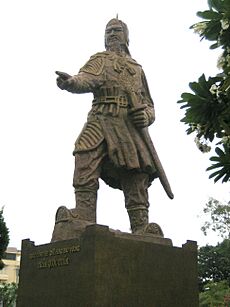
In 1257, the Mongol Empire attacked Đại Việt for the first time. The Mongols wanted to pass through Đại Việt to attack the Song dynasty in China. Emperor Trần Thái Tông did not want them to cross his land. The Đại Việt army used elephants, but the Mongols defeated them.
At first, the Đại Việt army faced many defeats. Some officials even suggested escaping to China. But Trần Thái Tông decided to make peace with the Mongols in 1258. Đại Việt agreed to have a friendly relationship with the Mongols. They also sent gifts, but still kept ties with the Song dynasty.
The Mongol leader, Kublai Khan, was not happy with this arrangement. He wanted more gifts and more control. In 1283, he told the Trần dynasty he wanted to send his armies through Đại Việt to attack the kingdom of Champa. He demanded supplies for his army.
In 1284, the Mongols launched their second invasion. Prince Toghon led the attack from the north. The Mongol navy, led by general Sogetu, came from the south. The Trần emperors, Trần Thánh Tông and Trần Nhân Tông, had to retreat. Some officials even joined the Mongols.
But the Trần army fought back. In 1285, they won important battles at Hàm Tử and Chương Dương. The Mongol navy was almost destroyed. Sogetu was killed. The Trần emperors returned to their capital, Thăng Long.
In 1287, the Mongols attacked for a third time. This time, General Trần Quốc Tuấn (also known as Prince Hưng Đạo) was confident they could win. After the Mongols looted the capital, they decided to retreat. This invasion ended with a huge defeat for the Mongol navy at the Battle of Bạch Đằng in 1288.
General Trần Quốc Tuấn, Prince Trần Khánh Dư, and General Phạm Ngũ Lão were key heroes in these victories. After this, Đại Việt and Champa agreed to be friendly with the Mongols to avoid more wars.
Peace and Expansion Southward
After the Mongol invasions, there was a long period of peace and growth. This was during the reigns of Emperors Trần Anh Tông, Trần Minh Tông, and Trần Hiến Tông. Anh Tông was the first Trần emperor who did not have to fight the Mongols.
Even though important generals like Trần Quang Khải and Trần Quốc Tuấn died, the empire had many skilled officials. Anh Tông was strict against bad behavior like gambling and corruption. But he also rewarded those who served him well.
In 1306, the king of Champa, Chế Mân, offered two of his regions to Đại Việt. This was in exchange for marrying Vietnamese princess Huyền Trân. Anh Tông accepted. These regions became known as Thuận Hóa.
A year later, Chế Mân died. According to Champa tradition, Huyền Trân was supposed to be burned with her husband. Anh Tông sent an official to save her. She returned to Đại Việt. However, the new Champa king did not want peace. In 1312, Anh Tông led an army to attack Champa. Chế Chí, the Champa king, was captured. Relations between Đại Việt and Champa remained difficult.
Challenges and Decline
After the death of the retired Emperor Trần Minh Tông in 1357, the Trần dynasty started to face problems. Emperor Trần Dụ Tông spent a lot of money building fancy palaces. He also brought theatre, which was seen as improper, into the royal court. He died young in 1369. He chose Dương Nhật Lễ, who was not from the Trần family, to be the next emperor.
Dương Nhật Lễ did not focus on his duties. This made many people in the court unhappy. The Prime Minister tried to remove him, but the plot was discovered, and they were killed.
In 1370, Trần Phủ, the emperor's father-in-law, gathered an army. He overthrew Nhật Lễ and became the new emperor, Trần Nghệ Tông. Nhật Lễ was later killed.
After Nhật Lễ's death, his mother asked King Chế Bồng Nga of Champa to attack Đại Việt. Chế Bồng Nga took advantage of Đại Việt's problems. He attacked Thăng Long, the capital. The Trần royal family had to escape. Chế Bồng Nga looted the capital before leaving.
In 1376, Emperor Trần Duệ Tông led a military campaign against Champa. But the Đại Việt army suffered a terrible defeat. The emperor and many high-ranking officials were killed. The next emperors could not stop Chế Bồng Nga's invasions. In 1390, General Trần Khát Chân finally defeated Champa and killed Chế Bồng Nga. This brought stability to the southern part of Đại Việt.
The End of the Trần Dynasty
During the reign of Trần Nghệ Tông, an official named Hồ Quý Ly gained a lot of power. He was related to the imperial family. Even though he was involved in the death of Emperor Duệ Tông, Nghệ Tông trusted him. Hồ Quý Ly became very powerful in the court.
Emperor Trần Phế Đế tried to reduce Hồ Quý Ly's power. But Hồ Quý Ly spread bad rumors about the emperor. This led Nghệ Tông to replace Phế Đế with Trần Thuận Tông in 1388. Trần Nghệ Tông died in 1394, leaving Hồ Quý Ly in complete control.
Hồ Quý Ly started to change the government and examination systems. In 1397, he made Thuận Tông move the capital from Thăng Long to Thanh Hóa.
In 1398, Hồ Quý Ly forced Thuận Tông to give up the throne to his three-year-old son, Trần Thiếu Đế. Thuận Tông was only 20 years old. A year later, Hồ Quý Ly had Thuận Tông killed. He also ordered the execution of over 370 people who opposed him. This included many important officials and royal relatives.
The Trần dynasty officially ended on March 23, 1400. Hồ Quý Ly removed Thiếu Đế from power and started his own dynasty, the Hồ dynasty. Since Thiếu Đế was Hồ Quý Ly's grandson, he was not killed.
Later Attempts to Restore the Trần Dynasty
After the Ming dynasty conquered the Hồ dynasty in 1407, Prince Trần Ngỗi tried to bring the Trần dynasty back. He led forces against the Chinese. He won some battles but could not retake the capital. His efforts failed due to internal conflicts.
A new emperor, Trùng Quang Đế, was chosen in 1409. The Trần loyalists held the southern regions for a while. But they were finally defeated by the Ming forces in 1413.
Economy and Society
Economic Reforms and Daily Life
To fix the economy, which was damaged at the end of the Lý dynasty, Emperor Trần Thái Tông changed the tax system. He introduced a new personal tax based on how much land a person owned. For example, a farmer with a small amount of land paid one quan per year. Farmers also paid a land tax with rice. The Trần dynasty taxed many things, from fish to fruits.
Handicrafts, cotton, silk, and fancy fabrics grew quickly. Some of these items were sold to China. Mining for silver, gold, tin, and lead also increased, helping jewelry making. The government also made its own copper coins and weapons.
Shipbuilding also expanded. They built large ships with 100 oars. Thăng Long became a busy trading center with many markets. A visitor from Mongolia in the 1200s said markets were held twice a month and had "plenty of goods." Inns were also set up along state roads.
Emperor Trần Thánh Tông encouraged Trần family members to use their land by hiring poor people to farm it. To help farming, Trần Thái Tông ordered new levees (dikes) to be built along the Red River in 1244. Farmers whose land was used for dikes were paid for it. An official was also put in charge of this system.
Towards the end of the Trần dynasty, Hồ Quý Ly made big changes to the economy. The most important change was replacing copper coins with paper money in 1396. This was the first time paper money was used in Vietnam. The emperor also set up trading posts for Chinese merchants.
Culture and Arts
Literature and Language
Literature during the Trần dynasty was very important. Even though the Trần family started without much education, they valued culture. They especially focused on literature.
Two main types of literature were popular: patriotic and Buddhist. To celebrate the victory against the Mongols, the general Trần Quang Khải wrote a famous poem called Tụng giá hoàn kinh (Return to the capital). General Trần Quốc Tuấn wrote Hịch tướng sĩ (Call of Soldiers), which was a powerful call to arms. These works showed great love for the country.
Many officials and scholars also wrote patriotic works. Since Buddhism was very important, many writings showed Buddhist ideas. Emperor Trần Nhân Tông and other Buddhist masters wrote many such works.
Besides official literature, folk stories, myths, and ghost stories were collected. Việt Điện U Linh Tập and Lĩnh Nam chích quái are two important collections. They tell us a lot about folk culture and early Vietnamese history.
The Trần dynasty was special because it started using and developing the Vietnamese language written in chữ Nôm. Before this, Vietnamese was mostly spoken. Under Emperor Trần Nhân Tông, chữ Nôm became the second official language in the royal court, alongside Chinese.
Hàn Thuyên, an official, was one of the first to write poems in chữ Nôm in 1282. After him, more scholars used chữ Nôm. This helped the Vietnamese language and literature grow a lot.
Performing Arts and Festivals
The Trần dynasty was a great time for music and culture. Theatre grew quickly, even though some people thought it was not proper. A captured Chinese soldier, Lý Nguyên Cát, helped bring many features of Chinese theatre to Đại Việt. He is often seen as the founder of hát tuồng (Vietnamese classical opera).
To celebrate the 1288 victory over the Mongols, Trần Quang Khải and Trần Nhật Duật created the Múa bài bông (dance of flowers). This dance was part of a big three-day festival. It is still performed at festivals today.
Education and Imperial Examinations
Even though Buddhism was the main religion, Confucianist education also spread. Students learned about the Four Books and Five Classics and Chinese history. These were first taught in Buddhist temples. Later, retired officials and scholars opened private classes.
One of the most famous teachers was Chu Văn An. He was an official and taught the Crown Prince. Emperor Trần Thánh Tông also allowed his smart brother, Trần Ích Tắc, to open his own school. Many future important officials studied there.
The official school, Quốc học viện, was opened in 1253. It taught imperial students. A military school, Giảng võ đường, also opened to teach about war. The first Temple of Military Men was built to honor famous generals.
Seven years after the Trần dynasty began, Emperor Trần Thái Tông held the first imperial examination in 1232. This was to choose the best scholars for important jobs. Later, the emperor started holding these exams every seven years.
The highest title in these exams was tam khôi (three first laureates). These were the top three students. The first tam khôi included Nguyễn Hiền, who was only 12 years old. Lê Văn Hưu, who later became a historian, was also one of them.
In 1256, the Trần dynasty divided the top title into two groups. One was for students from northern regions, and one for students from southern regions. This was to encourage students from far away. This separation ended in 1275.
In 1304, Emperor Trần Anh Tông made the examination system more standard. It had four rounds. Hồ Quý Ly later changed this system in 1396 as part of his reforms.
During its 175 years, the Trần dynasty held fourteen imperial examinations. Many winners became important officials or famous scholars. These included Lê Văn Hưu, who wrote historical books, and Mạc Đĩnh Chi, a famous envoy.
Science and Technology
Advancements in Science and Tools
The Trần dynasty used feng shui (a system of arranging things to bring good luck). For example, in 1248, Trần Thủ Độ ordered feng shui masters to block certain areas to protect the new dynasty.
Historical records don't give many details about science achievements. But a scientist named Đặng Lộ was mentioned. He invented a tool called lung linh nghi, which was like an armillary sphere. It was used to measure stars. From his observations, Đặng Lộ convinced the emperor to change the calendar in 1339. This made it fit better with farming seasons.
Gunpowder and Warfare
Towards the end of the Trần dynasty, gunpowder technology appeared. It was used in 1390 when General Trần Khát Chân fired a cannon from his ship. This killed the King of Champa, Chế Bồng Nga.
Some researchers believe the Trần dynasty got gunpowder technology from China. They used it well, which changed the power balance between Đại Việt and Champa. The need for copper to make firearms might have been why Hồ Quý Ly changed to paper money in 1396.
The Trần and later Hồ dynasties kept improving their firearms. Their weapons became even better than Chinese ones. The Ming dynasty later took these advanced weapons when they invaded Đại Việt.
Medicine and Health Care
During the Trần dynasty, medicine also grew. In 1261, the emperor created the Institute of Imperial Physicians. This institute managed medicine in Đại Việt. They tested new doctors and treated people during epidemics. In 1265, they gave out a pill called Hồng ngọc sương to the poor. They believed it could cure many diseases.
Besides traditional Chinese herbs, Trần doctors also started using local Vietnamese herbs. They used these to treat both common people and soldiers.
A famous monk and doctor named Phạm Công Bân, also known as Tuệ Tĩnh, is called the "Father of the Southern Medicine." He created the basis for Vietnamese traditional medicine. His books, Hồng nghĩa giác tư y thư and Nam dược thần hiệu, contained many simple remedies using local herbs. They offered thousands of prescriptions for various diseases.
Images for kids
-
Bình Sơn pagoda of Vĩnh Khánh Temple, Trần dynasty, Tam Sơn town, Lô river commune, Vĩnh Phúc province.
-
The handscroll "The Mahasattva of Truc Lam comes out of the mountains" shows Thái thượng hoàng Trần Nhân Tông arriving near Thăng Long from his quiet retreat.
Family Tree
 |
| Thái Tổ | |||||||||||||||||||||||||||||||||||||||||||||||||
| Thái Tông | |||||||||||||||||||||||||||||||||||||||||||||||||
| Thánh Tông | |||||||||||||||||||||||||||||||||||||||||||||||||
| Nhân Tông | |||||||||||||||||||||||||||||||||||||||||||||||||
| Anh Tông | |||||||||||||||||||||||||||||||||||||||||||||||||
| Minh Tông | |||||||||||||||||||||||||||||||||||||||||||||||||
| Nghệ Tông | Hiến Tông | Dụ Tông | Duệ Tông | Cung Túc | |||||||||||||||||||||||||||||||||||||||||||||
| Thuận Tông | Phế Đế | Nhật Lễ | |||||||||||||||||||||||||||||||||||||||||||||||
| Thiếu Đế | |||||||||||||||||||||||||||||||||||||||||||||||||
See also
- List of emperors of the Trần dynasty


